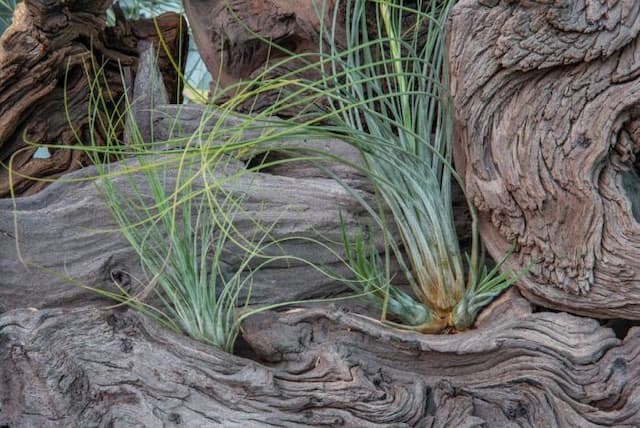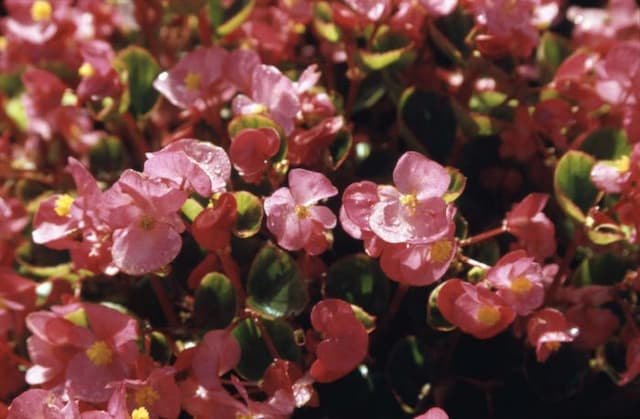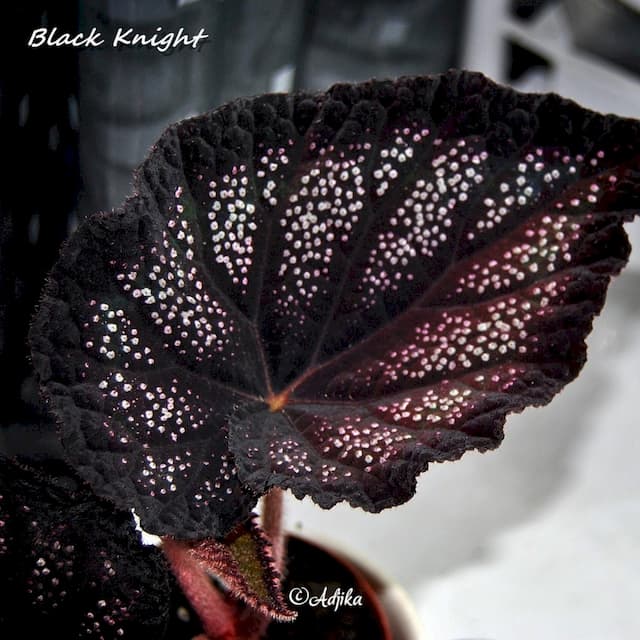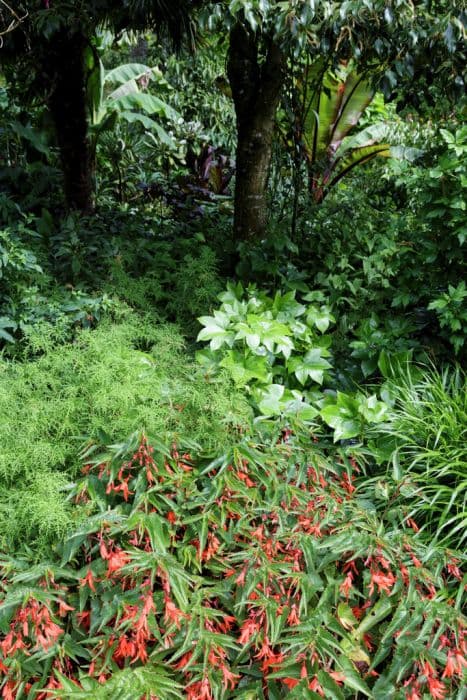Fuchsia begonia Begonia foliosa var. miniata

ABOUT
B. foliosa var. miniata is a bushy branching perennial to 60cm with small, rich glossy green leaves and pendulous, fuchsia-like pink or red flowers 3cm across
About this plant
 Names
NamesFamily
Begoniaceae
Synonyms
Fern-leaf Begonia, Vine-leaved Begonia, Red-flowered Shrubby Begonia
Common names
Begonia fuchsioides, Begonia fuchsioides var. miniata, Begonia miniata.
 Characteristics
CharacteristicsLife cycle
Perennials
Foliage type
Evergreen
Color of leaves
Green
Flower color
Pink
Height
2-3 feet (0.6-0.9 meters)
Spread
2 feet (0.6 meters)
Plant type
Shrub
Hardiness zones
10
Native area
Colombia
Benefits
 General Benefits
General Benefits- Aesthetic Appeal: Adds vibrant color and texture to gardens with its delicate foliage and bright scarlet flowers.
- Low Maintenance: Requires minimal care once established, making it suitable for busy individuals or those new to gardening.
- Attracts Pollinators: The flowers can attract butterflies and hummingbirds, which helps to pollinate nearby plants.
- Container Gardening: Suitable for growing in pots and hanging baskets, making it versatile for people with limited space.
- Shade Tolerance: Adapts well to shaded areas where many other flowering plants may not thrive.
- Seasonal Interest: Provides year-round interest due to evergreen leaves in mild climates and flowering that may occur in multiple seasons.
- Design Versatility: Can be used in various garden styles including rockeries, woodland settings, and as underplanting for larger shrubs.
 Medical Properties
Medical PropertiesThis plant is not used for medical purposes.
 Air-purifying Qualities
Air-purifying QualitiesThis plant is not specifically known for air purifying qualities.
 Other Uses
Other Uses- Crafts and Decor: Begonia foliosa var. miniata is sometimes used for crafting decorative objects or adding a unique touch to floral arrangements due to its cascading foliage and bright flowers.
- Educational Model: Biology teachers may use Begonia foliosa var. miniata to demonstrate plant growth habits, leaf morphology, and flower structures in classrooms.
- Holiday Decor: During festive seasons, this plant can be incorporated into Christmas or holiday wreaths for a pop of color and a tropical feel.
- Photography Prop: Photographers may use Begonia foliosa var. miniata as a natural prop for botanical photography, benefiting from its elegant appearance.
- Miniature Gardens: Due to its small stature, Begonia foliosa var. miniata is often a great choice for creating fairy gardens or terrarium landscapes.
- Living Jewelry: Crafters can use the tiny blooms or leaves of Begonia foliosa var. miniata to create living earrings or necklaces by enclosing them in clear resin.
- Event Favors: Potted Begonia foliosa var. miniata can be gifted as eco-friendly favors for weddings or garden parties encouraging guests to grow their own plants.
- Art Inspiration: Artists may draw inspiration from the intricate patterns and vibrant colors of Begonia foliosa var. miniata for paintings, textile designs, or other art forms.
- Study of Adaptation: The plant can serve as a subject in studies or discussions about adaptation and survival, as it is adept at thriving in various conditions.
- Culinary Garnish: While not commonly used in cuisine, the flowers of the Begonia foliosa var. miniata could potentially be used as an edible garnish for a luxurious touch on special dishes, provided they are confirmed to be free from any harmful treatments and are indeed edible.
Interesting Facts
 Feng Shui
Feng ShuiThe Begonia is not used in Feng Shui practice.
 Zodiac Sign Compitability
Zodiac Sign CompitabilityThe Begonia is not used in astrology practice.
 Plant Symbolism
Plant Symbolism- Beware: Begonias are often associated with a warning to be cautious or wary. This may be due to the plant's delicate appearance, suggesting vulnerability.
- Gratitude: The begonia symbolizes deep appreciation and gratitude, making it an ideal gift to express thankfulness.
- Uniqueness: With its various shapes and colors, the begonia can represent individuality and the beauty of being distinct.
- Harmony: The balance of the begonia's features symbolizes harmony and can be a reminder to find peace within one's environment.
 Water
WaterThe Begonia foliosa, commonly referred to as the Fernleaf Begonia, should be watered when the top inch of soil feels dry to the touch. Depending on environmental conditions like humidity and temperature, this may mean watering approximately once a week. Use lukewarm water and provide enough to moisten the soil throughout the pot—typically about 8 to 16 ounces, depending on the size of the pot. Be sure to avoid soggy soil as this can lead to root rot. During the winter months, reduce watering frequency as plant growth naturally slows down.
 Light
LightFernleaf Begonias thrive in bright, indirect light, making an east- or west-facing window an ideal spot. They can tolerate some morning sunlight but must be shielded from the harsh midday sun that can scorch their delicate leaves. If natural light is limited, placing them under fluorescent lighting may also help them flourish.
 Temperature
TemperatureFernleaf Begonias prefer temperatures between 60 and 75 degrees Fahrenheit, making them suitable for typical indoor environments. They can tolerate a minimum temperature of around 50 degrees Fahrenheit but should be protected from drafts and sudden temperature changes. The ideal temperature range supports healthy growth and flowering.
 Pruning
PruningPruning Fernleaf Begonias encourages a bushier growth habit and removes any leggy or dead stems. Prune lightly throughout the growing season as needed, cutting just above a leaf node or bud. The best time for a more thorough pruning is in the early spring before new growth begins. Pruning seasonally helps maintain the plant’s shape and encourages more vibrant foliage and blooms.
 Cleaning
CleaningAs needed
 Soil
SoilThe best soil mix for Fern-leaf Begonia is a well-draining, porous mix with peat, pine bark, and perlite or vermiculite. The ideal soil pH for this begonia should be slightly acidic, ranging between 5.5 and 6.5.
 Repotting
RepottingFern-leaf Begonia should be repotted every 1-2 years, or when it has outgrown its current container. Repotting in spring is preferable as the plant will quickly recover and grow into the new space.
 Humidity & Misting
Humidity & MistingFern-leaf Begonia thrives at high humidity levels, ideally between 50% and 60%. Humidity can be increased with a pebble tray or humidifier to create the optimal environment for the plant.
 Suitable locations
Suitable locationsIndoor
Place Fern-leaf Begonia in bright, indirect light with high humidity.
Outdoor
Shelter Fern-leaf Begonia from direct sun; ensure high humidity and warmth.
Hardiness zone
10-11 USDA
 Life cycle
Life cycleThe Coral Begonia (Begonia foliosa var. miniata) begins its life cycle as a seed, which, when sown in a moist medium and given the right temperature and light conditions, will germinate. The seedling stage follows germination, where the plant develops its first set of true leaves. As it enters the vegetative stage, the Coral Begonia grows rapidly, producing its characteristic small, glossy, and heavily serrated leaves. Upon reaching maturity, it will produce clusters of vibrant red or pink flowers, especially if given plenty of light and kept in cooler temperatures. After pollination, which often relies on insects, the flowers will set seed for the next generation. Lastly, like many perennials, the Coral Begonia may enter a dormancy phase, particularly in cooler seasons or when experiencing drought stress, reducing growth until conditions become favorable again.
 Propogation
PropogationPropogation time
Spring-Early Summer
The most popular method of propagating Begonia foliosa var. miniata, commonly known as Fuchsia Begonia or Fernleaf Begonia, is by stem cuttings. This process is ideally undertaken in spring or early summer when the plant's growth is most active. To propagate, a healthy stem cutting about 3-4 inches (7.5-10 cm) long with a few leaves is taken from the mother plant using a sharp, sterile cutting tool. The lower leaves are carefully removed, and the cut end may be dipped in rooting hormone powder to encourage root development, though this is optional. The cutting is then inserted into a pot filled with a well-draining potting mix, ensuring at least one node (where the leaves were removed) is buried in the soil. The pot should be placed in a warm spot with indirect sunlight and kept evenly moist but not waterlogged. Roots usually develop within a few weeks, after which the new plant can be gradually acclimatized to typical growing conditions.

![Begonia [Allure]](/_next/image?url=https%3A%2F%2Fplants-admin.emdemapps.com%2Fimages%2Fplants%2F%2Fimages%2F604b5b9006ab9.png&w=640&q=75)







